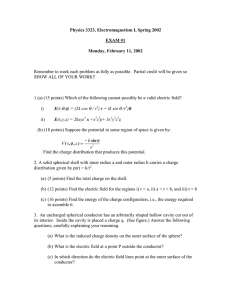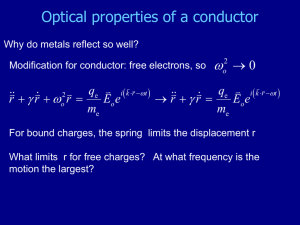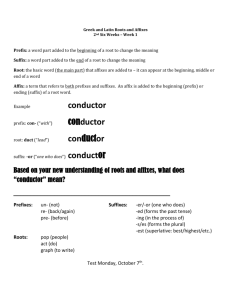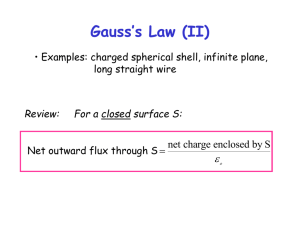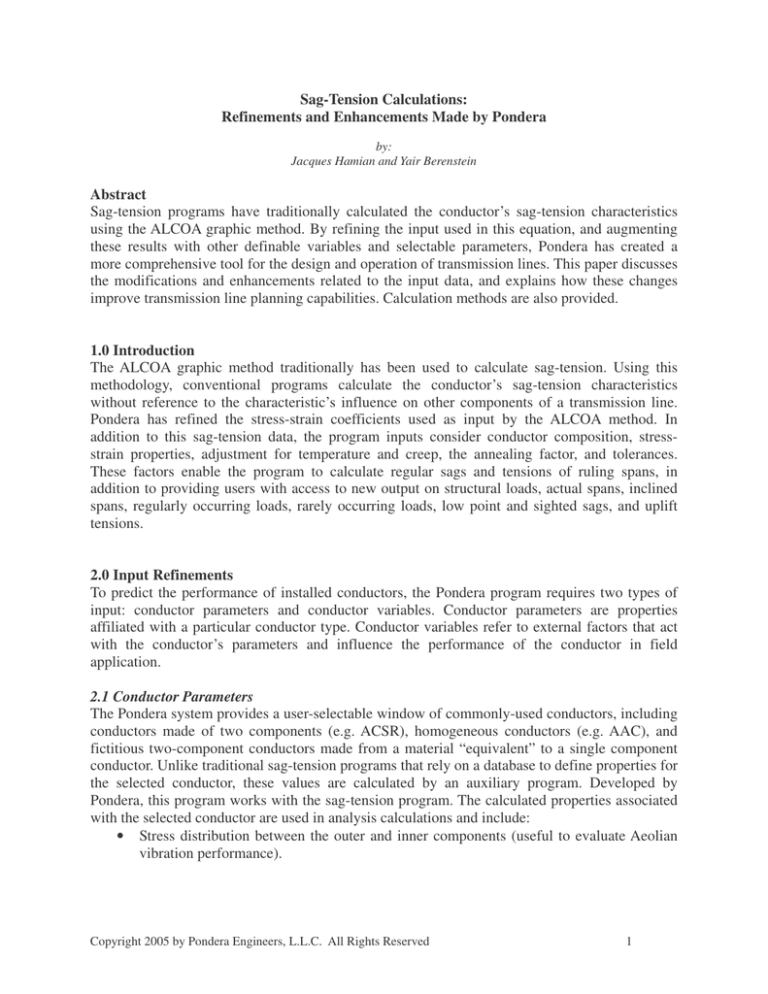
Sag-Tension Calculations:
Refinements and Enhancements Made by Pondera
by:
Jacques Hamian and Yair Berenstein
Abstract
Sag-tension programs have traditionally calculated the conductor’s sag-tension characteristics
using the ALCOA graphic method. By refining the input used in this equation, and augmenting
these results with other definable variables and selectable parameters, Pondera has created a
more comprehensive tool for the design and operation of transmission lines. This paper discusses
the modifications and enhancements related to the input data, and explains how these changes
improve transmission line planning capabilities. Calculation methods are also provided.
1.0 Introduction
The ALCOA graphic method traditionally has been used to calculate sag-tension. Using this
methodology, conventional programs calculate the conductor’s sag-tension characteristics
without reference to the characteristic’s influence on other components of a transmission line.
Pondera has refined the stress-strain coefficients used as input by the ALCOA method. In
addition to this sag-tension data, the program inputs consider conductor composition, stressstrain properties, adjustment for temperature and creep, the annealing factor, and tolerances.
These factors enable the program to calculate regular sags and tensions of ruling spans, in
addition to providing users with access to new output on structural loads, actual spans, inclined
spans, regularly occurring loads, rarely occurring loads, low point and sighted sags, and uplift
tensions.
2.0 Input Refinements
To predict the performance of installed conductors, the Pondera program requires two types of
input: conductor parameters and conductor variables. Conductor parameters are properties
affiliated with a particular conductor type. Conductor variables refer to external factors that act
with the conductor’s parameters and influence the performance of the conductor in field
application.
2.1 Conductor Parameters
The Pondera system provides a user-selectable window of commonly-used conductors, including
conductors made of two components (e.g. ACSR), homogeneous conductors (e.g. AAC), and
fictitious two-component conductors made from a material “equivalent” to a single component
conductor. Unlike traditional sag-tension programs that rely on a database to define properties for
the selected conductor, these values are calculated by an auxiliary program. Developed by
Pondera, this program works with the sag-tension program. The calculated properties associated
with the selected conductor are used in analysis calculations and include:
• Stress distribution between the outer and inner components (useful to evaluate Aeolian
vibration performance).
Copyright 2005 by Pondera Engineers, L.L.C. All Rights Reserved
1
•
Conductor tension at higher temperatures, which is carried entirely by the inner
component resulting in smaller sags. This feature can be turned on or off at the discretion
of the user.
As new conductors are requied, the auxiliary program requires minimal input: conductor type,
stranding, and size (e.g. ACSR, 26/7, and MCM). Using this data, the program calculates the
required properties. These calculated values can be reviewed, modified, and stored for use by the
sag-tension program. Coefficients for new conductors are also calculated using known
coefficients originating from third parties, such as The Aluminum Association and ALCOA, and
standard or conventional stress-strain-creep (S-S-C) charts. This feature makes it faster and
simpler to analyze new conductors.
2.1.1. Stress-Strain Properties
Traditionally, stress-strain (S-S) properties used in the ALCOA method have been
defined through polynomials of the third and four orders, namely four or five coefficients
for each component. While these polynomials are accurate and satisfactory, they result in
errors at higher conductor strains.
1-hr S-S data for the Steel Portion of ACSR
250
Typical Coeffs
Pondera Coeffs
Actual curve
Stress (Ksi)
200
150
100
50
0
0
1
2
3
4
Strain (%)
Graph 1: Comparison stress-strain values.
For example, Graph 1 illustrates the typical performance of the steel core of an ACSR
conductor. Its predicted behavior, as determined by traditionally-used polynomials, is
also charted. Next, it’s stress-strain characteristics are plotted based on Pondera’s
enhanced sag-tension program. As the graph illustrates, Pondera’s proprietary program
Copyright 2005 by Pondera Engineers, L.L.C. All Rights Reserved
2
exactly maps to the laboratory-tested cable performance. These more accurate stressstrain values are calculated by the Pondera program using either coefficients from third
parties, standard laboratory test data, or published cable information.
2.2 Conductor Variables
2.2.1 Ruling Spans & Actual Spans
Sag-tension programs universally provide sags and tensions only for specified ruling
spans, without reference to actual spans. Pondera’s new sag-tension program clearly
highlights the distinction between a ruling span and the actual span range that can be
encountered within each ruling span. It also enables the design engineer to define the
difference in elevation between the anchor points of any actual span.
Usually, instead of making the necessary calculations for the actual span, transmission
line designers have simply substituted the ruling span sag and tension data for the actual
span sag and tension data. This substitution introduces unnecessary errors, inefficiencies,
and/or increased costs in the line design. Additionally, the actual spans are rarely, if ever,
level spans as implied in the ruling span calculations.
These calculations are fully integrated into the main program and do not require reruns or
other manual calculations.
2.2.2 Stringing Table
The standard program output shows the stringing sags for a number of actual spans
ranging between the minimum and maximum expected actual spans within each ruling
span. The design engineer has the option of specifying the required number of
intermediate actual spans and can request the stringing data for special actual and
inclined spans. This feature can be turned on or off.
2.2.3 Regularly& Rarely Occurring Loads
The program distinguishes between regularly and rarely occurring load cases. This allows
design engineers to evaluate designs for typical weather conditions, as well as assess
rarely occurring loads to ensure that the structure load capacities are not exceeded in
extreme circumstances.
Regularly occurring loads are those that a line may experience as soon as it is energized,
such as unloaded 18°C to 100°C (0o to 212o F) and NESC heavy/medium/light loads. The
final sags and tensions are calculated after occurrence of these loads.
Rarely occurring loads allow for line evaluation in unusual conditions, which the line
may infrequently, or perhaps never, experience during its economic lifetime. However,
the ability to evaluate rarely occurring loads is essential for preventing catastrophic
events without unnecessarily increasing the number of structures throughout the line. The
user has the option to designate these loads as rare and the program will then:
• calculate the conductor tensions and structure loads corresponding to such loads
• provide final sags resulting only from the regular loads
Copyright 2005 by Pondera Engineers, L.L.C. All Rights Reserved
3
•
warn the line designer that resagging may be required if and where these loads
occur
2.2.4 Tolerances
The actual performance of a transmission line is dependent in part on the ability of the
design program to consider installation tolerances. In the past, these tolerances were often
predefined. When installation conditions were expected to vary from these tolerances,
designers had to manually adjust output or process the output through an alternative
program to obtain a more accurate representation of field performance, or elect to accept
the inaccuracy.
In the Pondera program, design engineers can define tolerances that are used by the
program to determine sags, tensions, temperatures, and arc lengths. This has eliminated
the manual or supplemental calculations and further enhanced modeling accuracy.
2.2.5 Annealing Factor
Historically, the impact conductor annealing has on line designs has been calculated
based on a limited number of data points, which are extrapolated to predict performance
at elevated temperatures. Pondera’s program uses the available conductor data and a
propriety algorithm to more accurately account for the annealing factor.
The accuracy of this data facilitates the creation of lines designed to operate at elevated
temperatures for extended periods of time and determines the impact temperatures (and
the annealing factor) will have on ground clearances after occurrence of operation under
emergency conditions.
3.0 Refined Outputs
Through the use of more accurate input parameters and variables, refinements in output provide
designers with enhanced information about creep, tension, inclined spans and low point sags,
adjustments for temperature and creep, and unstressed conductor length. This output provides
designers with the information needed to assess the cost and performance of line designs.
3.1 Creep
In addition to providing sag-tension information for the standard ten year creep, Pondera’s new
program also can determine creep after any number of years of operation (refer to Graph 2). The
time period can be specified by the design engineer by changing one input parameter. This is a
unique feature as it does not require new creep tests or any modification in the conductor data
base. Again software packages are available to translate coefficients from third parties and creep
information from standard laboratory tests or from published information.
Copyright 2005 by Pondera Engineers, L.L.C. All Rights Reserved
4
10-Yr
1-hr
alcoa 1-hr
alcoa 10-yr
1-hr itron
and
10-yr itron
Stress/Strain
for complete
1 -hr and 10-Yr Conductor
S/S for complete Conductor
39,800
34,800
29,800
1-hr (Pondera & Alcoa)
Pondera 10-yr
Pondera 1-hr
Stress (psi)
24,800
Alcoa 1-hr
19,800
Alcoa 10-yr
14,800
10-Yr
(Pondera=Alcoa)
9,800
4,800
-200
-0.01
0.09
0.19
0.29
0.39
0.49
0.59
0.69
0.79
Strain (%)
Graph 2: Comparison data predicted by ALCOA process and Pondera calculations for one
hour and 10 years.
3.2 Tension
Traditional programs provide only the conductor tensions and leave the calculation of the
structure loads to the design engineer. The new program provides the vertical, transverse, and
longitudinal components of the tensions at the upper and lower points of support for specified
actual spans, initial, and final conditions. In particular, the vertical load at the lower point of
support indicates whether or not the structure is under uplift conditions.
By recognizing that the conductor tensions are different at various locations throughout a
catenary, the program applies the specified tension limits to the maximum T-tension in each
ruling span, while evaluating the conductor S-S-C properties from the average P-tension in each
ruling span. The program provides two options for calculating the P-tension:
• Conventional: Average between the tension at the low point of the catenary, H-tension,
and T-tension. This calculation is inappropriate to use in up-lift conditions, where the low
point is imaginary (outside the catenary).
• Accurate: Average between the tensions along the catenary at a number of equally spaced
intervals.
3.3 Inclined Spans & Low Point Sags
Traditional sag-tension programs are for level ruling spans, where low point sags, sighted sags,
and mid-span sags are one and the same. In the real world, spans are characterized by differences
in elevation between the two points of support. Pondera’s new program recognizes this, and
provides the low point sags and the sighted sags for each span (the mid-span sags are almost
identical to the sighted sags, even for inclined spans). For inclined spans, the program provides a
warning if there are uplift conditions and provides the sags at the low point of the catenary as
Copyright 2005 by Pondera Engineers, L.L.C. All Rights Reserved
5
well as the sighted sags. Under uplift conditions, the low point sags become imaginary and only
the sighted sags have significance.
3.4 Conductor Unit Weight Adjustment for Temperature & Creep
Traditional sag-tension programs use the fabricated conductor unit weight for their calculations.
Pondera’s new program adjusts the unit weight as a function of the temperature and creep. This
feature can be turned on or off at the discretion of the design engineer.
3.5 Unstressed Conductor Length
When line installations require spans across water, deep ravines, or other special construction
conditions, the Pondera program provides information to simplify installation. As part of the
standard output, the software has the ability to calculate cutting length of an unstressed
conductor at a specified cutting temperature to meet installation requirements for each ruling
span.
4.0 Calculations
Contact Pondera Engineers (info@ponderaengineers.com) to obtain calculations used to derive
some of the values discussed in this paper.
5.0 Conclusion
Since the introduction of the ALCOA method, little work has been done to improve sag-tension
calculations, while the method has proven useful for transmission line design.
Pondera’s work has enhanced the ALCOA method, providing designers with a tool for today’s
design environment. These enhancements have been achieved by refining program inputs related
to the conductor’s parameters and variables: stress-strain, ruling spans, actual spans, stringing
table, regularly and rarely occurring loads, tolerances, and the annealing factor. As a result of
refinements in these areas, the Pondera program uses data that more accurately represents the
characteristics of the conductor over its installed life. These characteristics are reflected in the
program’s output with respect to creep, tension, inclined spans, low point sags, conductor weight
adjustments, and unstressed conductor lengths. This output is essential for optimizing the design
and operation of transmission lines.
References
1. Theodore Varney, “ACSR Graphic Method for SAG-TENSION Computations,” Aluminum
Company of America, Pittsburgh, Pennsylvania, 1927.
2. Aluminum Company of America (ALCOA), “Graphic Methods for Sag-Tension
Calculations,” 1926, 1963
3. Alcan, “Graphic Methods for Sag-Tension Calculations,” 1950.
4. Southwire Company, “Overhead Conductor Manual,” 1994.
5. Paul F. Winkelman, “Sag-Tensions Computations and Field Measurements of Bonneville
Power Administration,” American Institute of Electrical Engineers, paper 59-900, 1959.
Copyright 2005 by Pondera Engineers, L.L.C. All Rights Reserved
6




